Tag: Main Street Report
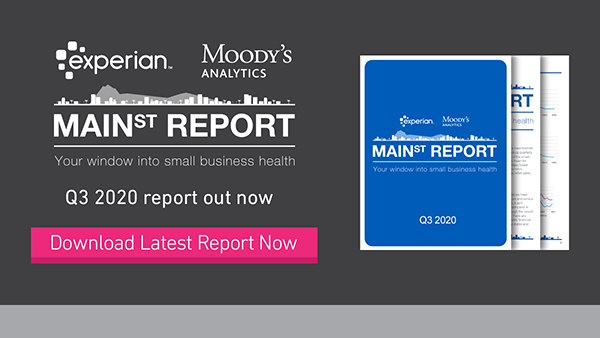
Experian and Moody's Analytics have just released the Q3 2020 Main Street Report. The report brings deep insight into the overall financial well-being of the small-business landscape, as well as offer... Experian and Moody's Analytics have just released the Q3 2020 Main Street Report. The report brings deep insight into the overall financial well-being of the small-business landscape, as well as offer commentary on business credit trends and what they mean for lenders and small businesses. In a fight for survival, small businesses have turned to layoffs and borrowing as they attempt to reach the other side of COVID-19. The increased borrowing is helping to mask rising late-stage delinquencies and bankruptcy. But these tactics can only mask weakness for so long. With another round of government stimulus unlikely to arrive before year's end, small businesses will need to borrow for survival again. While we did see some jobs come back in Q3, small business payrolls have shrunk by more than 2 million from this time last year. The hardest hit are those businesses with 1-19 and 20-49 employees; both of these groups saw payrolls shrink by 1 million employees. The 31-90 days past due (DPD) delinquency rate on small business credit plunged to 1.25 percent in the third quarter. This ended the streak of increasing delinquency we had observed for the last year. However, this is likely to be short-lived, as the US appears to have entered a new phase of the COVID-19 pandemic with cases again on the rise. Commercial and Industrial loans continued to run hot. C&I numbers are a lagging indicator, so the latest numbers reflect the second quarter. At that time new C&I lending was 21 percent higher than in the same period a year ago. If you would like to get the full analysis of the data behind the latest Main Street Report, join us for the Quarterly Business Credit Review webinar.
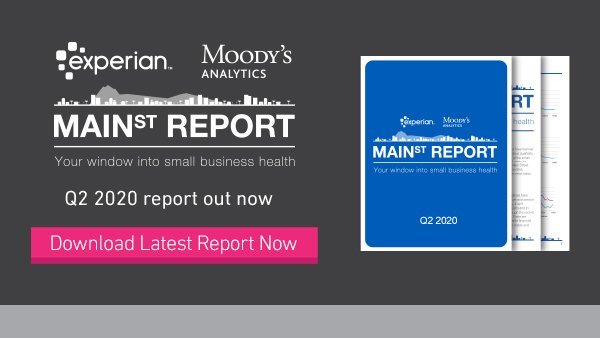
Experian and Moody's Analytics have just released the Q2 2020 Main Street Report. The report brings deep insight into the overall financial well-being of the small-business landscape, as well as offer commentary on business credit trends, and what they mean for lenders and small-businesses. Small businesses have turned to borrowing to survive periods of prolonged slumping sales, in many cases from government programs offering loan forgiveness. This increased borrowing has masked rising delinquent balances, but such a solution is a short-term fix. To keep their credit current, small businesses will need to find ways to generate revenue. Defaults are expected to rise in coming quarters as forbearance programs expire and as customers are likely to change their priorities in the wake of COVID-19. In Q2, moderate delinquency, defined as 31-90 days past due, rose to 1.66 percent from 1.61 percent, marking the fourth consecutive quarter of increasing delinquency, and the first year-over-year increase since this time last year. The closure of many state and local economies in April and the first half of May left many businesses facing severe revenue shortfalls in the second quarter. This environment has resulted in businesses listing poor sales as the second most important problem facing small businesses, according to the NFIB. If you would like to get the full analysis of the data behind the latest Main Street Report, presented by leading economists from Moody's Analytics and Experian, watch the Quarterly Business Credit Review webinar.
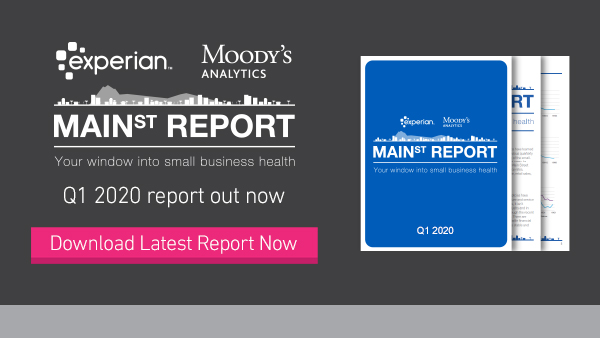
Experian and Moody's Analytics have just released the Q1 2020 Main Street Report. The report brings deep insight into the overall financial well-being of the small-business landscape, as well as offer commentary on business credit trends, and what they mean for lenders and small-businesses. After just one quarter, there’s no doubt the theme of 2020 is the pandemic, Covid-19. Unrelated to the pandemic, and subsequent shuttering of a swath of economies across the world, delinquencies rose in the first quarter. This was occurring as businesses reduced their borrowing. Lower borrowing will not have lasted long though, as government efforts to aid small business have taken the form of SBA lending. In Q1, the slowing of businesses pursuing credit pushed moderately delinquent balances up to 1.61 percent from 1.60 percent in the fourth quarter of 2019. # DPD Q1 19 Q4 19 Q1 20 Moderately delinquent 31–90 1.74% 1.60% 1.61% Severely delinquent 91+ 3.35% 2.29% 2.68% Bankruptcy 0.16% 0.16% 0.16% The bankruptcy rate was essentially flat in the first quarter, rising to 16.3 basis points from 16.1 in Q4. But the rate increased as fewer firms were reported as having active credit balances. The Federal Reserve’s Senior Loan Officer Survey indicates lenders are seeing higher demand than usual for Commercial & Industrial loans. This indicates the beginning of increasing loan demand this year, as small firms look to borrow to ride out lower consumer demand and remain in business. Watch the Quarterly Business Credit Review Get the full analysis of the data behind the Main Street Report by watching the experts from Experian and Moody’s in the Quarterly Business Credit Review.
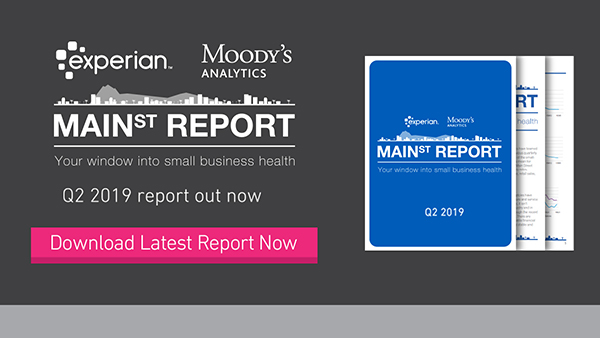
Experian and Moody’s Analytics have just released the Q2 2019 Main Street Report. The report brings deep insight into the overall financial well-being of the small-business landscape, as well as providing commentary on what certain trends mean for lenders and small businesses. Q2 Highlights In spite of business confidence in the second quarter, shaken by talk of trade war escalation, small businesses got a helping hand from seasonal factors that combined to push delinquency rates down. Delinquency rates for businesses with fewer than 100 employees fell in the second quarter, decreasing the 31–90 days past due rate from 1.74 percent to 1.64 percent for the quarter. But agriculture’s problems continued as weather and trade conditions continued to weigh on small farms. These factors won’t be as helpful in the third quarter, so fundamentals or confidence will need to improve to propel performance and growth forward. Bankruptcies ticked up ever so slightly again in the second quarter coming in at over 16 basis points. The most recent data available, from Q4 2018, indicates an establishment growth rate of 2.3%. Enough of these new businesses will seek credit to ensure that, combined with existing borrowers, balances look set to grow for some time. Overall, small businesses continue to display little to no signs of broad-based weakness. What weakness exists is fairly well confined at either the regional or industry level, and the solid performance that has been the norm for the last several quarters looks set to continue. Watch Webinar Recording Experian and Moody's Analytics go in-depth on the Q2 2019 Main Street Report in the below webinar.
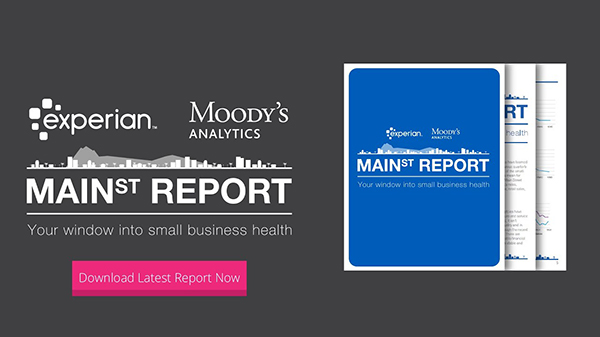
Experian and Moody’s Analytics have just released the Q1 2019 Main Street Report. The report brings deep insight into the overall financial well-being of the small-business landscape, as well as providing commentary on what certain trends mean for lenders and small businesses. In Q1 U.S. small businesses brushed off a government shutdown as stock markets recovered and income gains remained steady. Delinquency rates remained mostly stable, with pockets of weakness spread out among regions and industries, notably agriculture in the Great Lakes and manufacturing in the Southwest. Small firms seem to have simply shrugged off the headwinds of the first quarter and kept on with business as usual. Despite a fresh escalation in trade tensions, the year is starting off well with positive news coming from the areas presenting risks to the outlook. A dovish stance on interest rates from the Federal Reserve and room to grow in our housing market — 2019 is off to a strong start. Watch Webinar Recording - Q1 2019 Quarterly Business Credit Review Listen to the experts from Experian and Moody's Analytics go in-depth on insights revealed in the Q1 2019 Experian/Moody's Analytics Main Street Report.
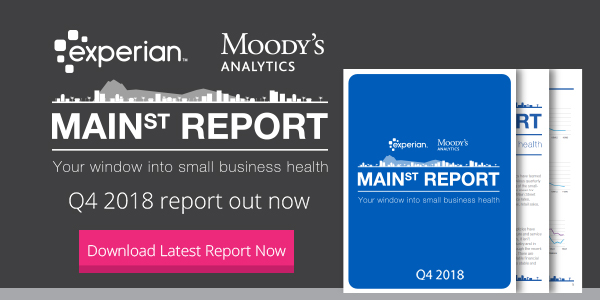
Experian has released the Experian/Moody's Analytics Main Street Report for Q4 2018. The report brings deep insight into the overall financial well-being of the small-business landscape, as well as providing commentary around what certain trends mean for credit grantors and the small-business community. Bucket 17Q4 18Q3 18Q4 Moderately Delinquent 31-90 1.68% 1.63% 1.68% Severely Delinquent 91+ 4.00% 3.40% 3.49% Bankruptcy BKC 0.16% 0.16% 0.16% The fourth quarter capped a second year of solid performance and growth for small-business credit, but there are signs that the period of moderation experienced during the past two years is over. Since the government shutdown has the potential to throw small-business lending a curve ball in the first half of 2019, the outlook for small-business credit is neutral. Conditions were positive in the fourth quarter, but this may not last long. Delinquency rates remained mostly stable, with pockets of weakness spread out among regions and industries, notably construction in the Plains. In addition to the 35-day shutdown, rising interest rates, destabilizing trade policy and slowing home-price growth are potential trouble sources that are already starting to impact some regions.
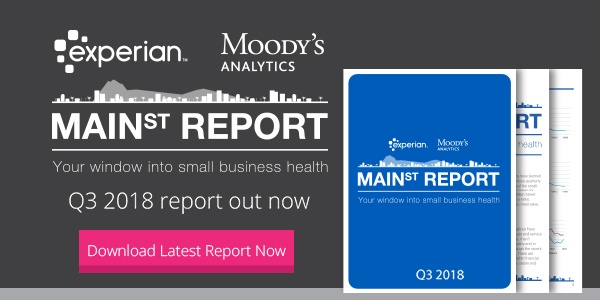
Today Experian and Moody's Analytics released the Q3 2018 Main Street Report. The report brings deep insight into the overall financial well-being of the small-business landscape, as well as providing commentary around what certain trends mean for credit grantors and the small-business community. For Q3 2018, the overall outlook for small-business credit is positive, but some industries such as construction have a negative outlook. Delinquency rates stable for now Delinquency rates are stable around their current levels, but this could change quickly if risks mount for certain industries. Continuing strength in the economy should keep small-business credit performance in check through the fourth quarter and early next year. Rising interest rates, destabilizing trade policy and slowing home-price growth are potential sources of trouble that are already starting to impact some regions. To bring insight to these Q3 business credit findings, Experian and Moody's Analytics will be presenting the Quarterly Business Credit Review for Q3 2018 on Tuesday, December 11th 10:00 a.m. (Pacific) 1:00 p.m. (Eastern). Read the report and bring your questions, we will be opening up the session for live Q&A as we dig into the numbers and the outlook for Q4 2018. We hope to see you there. Presenters: Gavin Harding Derrek G. McCrank Cristian deRitis
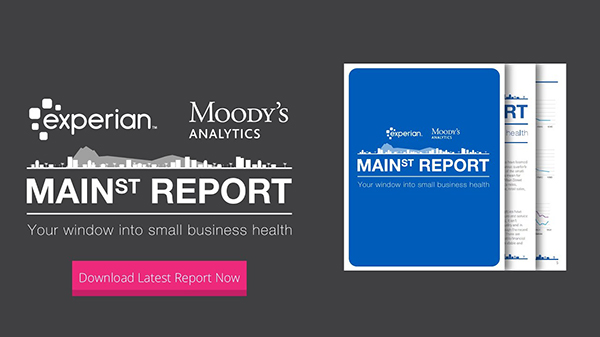
Today Experian Business Information Services releases the Experian/Moody's Analytics Main Street Report for Q1 2018. The report brings deep insight into the overall financial well-being of the small-business landscape, as well as providing commentary around what certain trends mean for credit grantors and the small-business community. Q1 2018 saw credit conditions loosening and balances rising as more businesses access credit. The report states the overall outlook for small-business credit is positive. Delinquencies were down and default rates rose slightly, suggesting that credit conditions have peaked as the economy is in a late-cycle expansion. Continuing strength in the macroeconomy will keep small-business credit moving in the near term, along with higher profits from the recently passed tax legislation. Small-business credit will be less certain in the medium to long term as rising wages, interest rates and changes to the tax code take a toll. Download the latest report
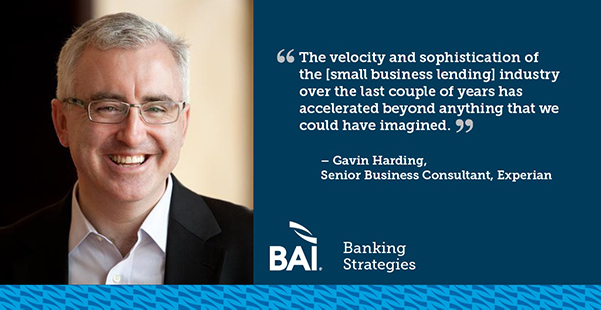
Click image to play the podcast This episode of the BIA Banking Strategies podcast was originally published on BAI Banking Strategies website. [Lou Carlozo]: For small businesses in 2018 the signs and indicators are complex. Bankruptcies are up, but credit conditions have finally shifted for the better. Some remain battle scarred and debt averse from the Great Recession. Yet, others see this as a time to aggressively pursue growth. How can banks make sense of these signs and take advantage of the times? To find out we'll talk with Gavin Harding Senior Business Consultant with Experian. [Lou Carlozo]: Welcome to BAI Banking Strategies where each week we'll focus on the key issues facing financial services leaders. We'll bring you objective opinions and actionable insights that will help you power smart decisions. I'm your host, Lou Carlozo, the managing editor of BAI, come on in. Don't miss our immersive annual event BAI Beacon which takes place in Orlando Florida October 9th through 11th. It takes a team to transform an organization and each team member has their own area of expertise that's critical to the effort. In the BAI Beacon, you can find the topics most relevant to your individual role and regroup at the end of the day with fresh perspective and ideas. Save 50 percent when you register before May 31. To find out more visit www.bai.org/baibeacon. [Lou Carlozo]: Thanks again for tuning into the podcast. It is great to have you here with us. And today on the program we have Gavin Harding the Senior Business Consultant with Experian Decision Analytics Global Consulting Practice. For more than half of his career Gavin held senior leadership positions with a large regional bank gaining experience in commercial and small business strategy, SBA lending, credit and risk management and sales. Gavin great to have you on the podcast today. [Gavin Harding]: Good to be here Lou. Thank you for inviting me. [Lou Carlozo]: Experian in conjunction with Moody's Analytics has this new report out the Main Street Report. Your window into small business health. So are small businesses healthy right now? [Gavin Harding]: Small businesses are very healthy right now. When you think of a small business's performance you think of it two ways one is in terms of you know revenue and overall health, and the other is in terms of access to credit how they pay their bills? For our purposes today we're thinking more about it from a lending banking perspective. From that perspective, bankruptcies are low and have been low for several quarters. Delinquencies are low and have been low for several quarters. So the fundamentals of small business are very robust very strong. [Lou Carlozo]: Small businesses are enjoying a great time. That doesn't mean of course that they're not without challenges and I'm going to read a portion of the report. Bankruptcies continued to rise in the fourth quarter making 2017 a full year in which bankruptcies increased every quarter. Taken alone this isn't good news but bankruptcies are coming off historical lows. Give us a little bit more insight as to what is going on here? [Gavin Harding]: Sure, so let's go back in time a little bit to the dreaded year 2008 when the world pretty much ended in financial terms. Massive turmoil. We tightened up credit. The whole industry worked through a series of losses. After a couple of years those portfolios were pretty well cleared out. So what was left was decent solid businesses with good fundamentals and a lot of the weak players had been essentially weeded out of the market. So time goes on, small businesses slowly start to invest but they were very leery of taking on a lot of debt but they had made it through the war. So those businesses had good credit performance. They were paying their bills and that went on for several years, and for I think it was 14 quarters. We saw that those small businesses continued to pay on time, continued to be good stewards. And then we get to 2017. [Lou Carlozo]: And then what? [Gavin Harding]: So in 2017 there was a lot of change. There had been limited investment from small business for a long time, and there is only so long that you can wait to invest. There comes a point when equipment breaks, when you need to hire people. Businesses became more optimistic. Lenders, bankers, fintech's started to open up the credit box a little bit broader standard. For 14 quarters we saw that those small businesses continued to pay on time, continued to be good stewards in terms of their investment. Good performance, very low bankruptcy levels, and then they really start to get a little optimistic a little confident, money starts to flow. We would expect that delinquencies would increase a little bit over time. We would expect that low bankruptcy rate to increase. So my perspective on that is that while it is something we should keep an eye on. It's very much an indication of growth, of confidence, of enthusiasm and investment. [Lou Carlozo]: What do you see as the most important context heading forward? [Gavin Harding]: The single most common question we have been asked over the last 18 to 24 months is when is it going to turn? And of course if we knew when it was going to turn I would be a retired multibillionaire. So the best we can do is look for indications right? and when we look for indications we look for those on a macro level, unemployment, and as we approach and reach full employment what does it do to wage growth? What does it do to access the human capital? And then we also look at it on a more micro level which is you know within our portfolio what are we seeing that's going to give us that hint? So if we start seeing instead of a gentle upward trend that we might think about in terms of a return to normality, if we start seeing for instance in our credit card portfolios for small businesses, those delinquencies spike, if we start to see those cards maxed out and delinquencies increase, that could be one of those very early signs. The other thing just keep in mind is this, the industry and when I say the industry I'm thinking about finance, over the last couple of years, has transformed in many ways. We all need to have a digital presence. We need to engage customers when they want to communicate with us. And when we need to do that with the products that they're looking for, and at the same time as we deliver this in a very slick quick way we have to maintain good solid robust risk management. And at the same time as we do all of that, we've got to make sure the fraudsters are held at bay and we minimize identity fraud and other types of fraud. So the whole industry has accelerated, it's very much now about digital technology. Customers are looking for quick and ready access. That opens all kinds of other risks for us. We're talking about integrated fraud risk. We are talking about you know advanced analytics on the portfolio. We are talking about operational risk, and our favorite kind of risk, regulatory risk, as we work to comply with regulations that are new and still evolving and haven't been tested yet. So it really is the velocity and sophistication of the industry over the last couple of years has just accelerated beyond anything I think we could have imagined. [Lou Carlozo]: I think the other consequence of this is clients sometimes getting jittery, getting nervous and one of the things that you specialize in is getting into those situations when things don't go as smoothly as a client might like, and offering some remediation, some help keeping things calm and moving forward. Tell us a little bit about how you do that work because you do it so well. [Gavin Harding]: We have clients that have either been in business a long time, or are relatively new to the space and there's often a common feature in the feature is, that they have grown many times grown rapidly, and what they had in place at the beginning was augmented and there was lots of other stuff bolted on. Prime example, banking client, regional bank, 67 separate systems and applications, none of which spoke to each other are connected. So you've got that rapid growth. You hit a certain kind of critical mass and you have to make the decision and the decision is are you going to stop assess, and identify a better way of doing things, and address all of these legacy systems and reports and legacy data and routines and processes? So in many cases working with clients we're able to stand back because we're outside right. We're outside, we know the industry, we've worked with a lot of clients but because we aren't involved in those processes day to day, we can look at them with a cold eye. We can assess them objectively against some of what we've seen other successful clients do. And in many cases, take heavily manual paper based processes and reports and decision making, and make it a lot more efficient, and by efficient, I don't mean you know automatic approvals I don't mean artificial intelligence. I mean old fashioned efficiency. So instead of doing something in ten steps can you do it in three. And when you take that analysis and you spread it across commercial lending for example, or through small business lending, there are some real opportunities to transform the process, to transform the experience of the people that have to work within the process, and ultimately to improve turnaround and accuracy the customer experience itself. [Lou Carlozo]: Turnaround accuracy. I would say this the banks and financial institutions are very fortunate to have you on their side. Gavin I want to thank you for making the time to be on the podcast today it was a real privilege. [Gavin Harding]: My pleasure. Thank you. [Lou Carlozo]: Gavin Harding is a Senior Business Consultant with Experian Decisions Analytics Global Consulting Practice. You can look for Gavin on LinkedIn. And here are three key takeaways from today's podcast: Bankruptcies are up for small businesses. In fact for four consecutive quarters in 2017 according to the Experian report. But that deserves a long view, post-recession. The small businesses that survived became very debt averse while banks tightened up lending. For small and medium sized businesses 2017 also marked a turning point to address needs such as replacing worn out equipment, or hiring badly needed staff. Some businesses haven't made it but it's nothing like the recession and it's a wave of doom. For small businesses in 2018 the news remains very positive, fundamentals are strong. Full employment is here, but there will always be potential storm clouds to keep an eye on. One is credit card delinquency spikes, another, moving too fast to address risks such as fraud. Businesses that have experienced rapid growth often suffer from bolted on systems and unconnected applications. In this case rapid growth means slowing it down. It comes down to four steps, stop, assess, identify and address. The endgame, find and implement efficiencies. [Lou Carlozo]: And now BAI Banking Strategies brings you the aha moment where our podcast guest shines a light on that point in time where realization revelation or exploration made all the difference in their financial services career. Now sometimes before you climb a mountain you've got to dig a hole and here Gavin Harding recalls how a visit from a federal regulator taught him a humbling lesson that he carries with him to this day. Listen. [Gavin Harding]: So let me take you back to Philadelphia in 1999. Being young and educated I was absolutely sure for a certainty that I knew pretty much everything I needed to know. And into that office walked a Federal Reserve auditor. He asked me a series of questions which I immediately answered, and over the course of an hour I dug a hole maybe 20 feet wide by 30 feet deep. Nice straight sides and I climbed on down into it. It took seven weeks and hundreds of files to undo the damage I did with reacting, with feeling, feeling that there had to be an answer that would be an answer now. With feeling that, as an executive, I had to have the answers. So my lesson from that experience and I keep it with me every day and it is part of every interaction with clients. First pause, and then clarify. So make room to think, understand that I didn't have to give an answer. Understand that "I'll get back to you" was a much better answer than a whole series of statements that may or may not have been connected, and were not thought out and were not researched. So I am greatly appreciative to the Federal Reserve for training me in 1999 in Philadelphia. This episode of the BIA Banking Strategies podcast was originally published on BAI Banking Strategies.
